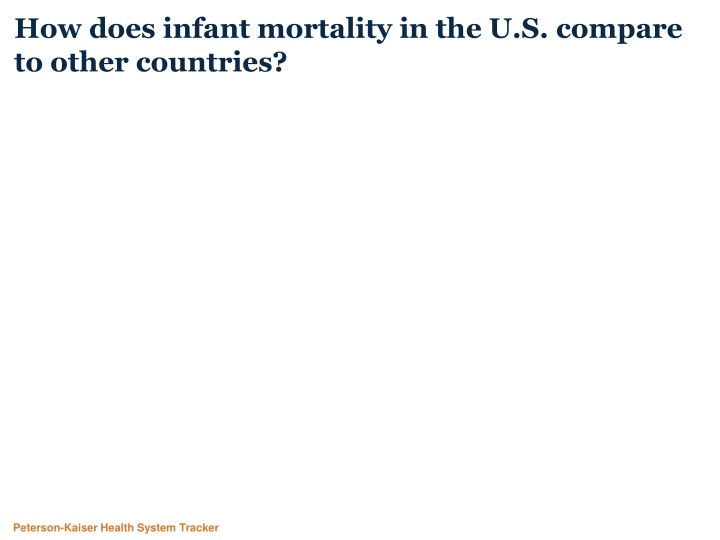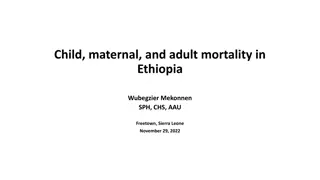
Infant Mortality Disparities Across Countries
Infant mortality rates in the U.S. are higher compared to other countries, with a particular disparity among non-Hispanic Blacks. Despite a decline in general infant mortality rates, the U.S. still lags behind comparable nations. Neonatal mortality in the U.S. also exceeds rates in similar countries, indicating ongoing challenges in infant healthcare.
Download Presentation

Please find below an Image/Link to download the presentation.
The content on the website is provided AS IS for your information and personal use only. It may not be sold, licensed, or shared on other websites without obtaining consent from the author. If you encounter any issues during the download, it is possible that the publisher has removed the file from their server.
You are allowed to download the files provided on this website for personal or commercial use, subject to the condition that they are used lawfully. All files are the property of their respective owners.
The content on the website is provided AS IS for your information and personal use only. It may not be sold, licensed, or shared on other websites without obtaining consent from the author.
E N D
Presentation Transcript
How does infant mortality in the U.S. compare to other countries? Peterson-Kaiser Health System Tracker
Infant mortality is higher in the U.S. than in comparable countries Infant mortality per 1,000 live births, 2013 United States 6 Canada Switzerland United Kingdom Netherlands France Australia Belgium Comparable Country Average 3.5 Germany Austria Sweden Japan 2.1 0 1 2 3 4 5 6 7 Source: OECD (2013), "OECD Health Data: Health status: Health status indicators", OECD Health Statistics (database). doi: 10.1787/data-00349-en (Accessed on August 6, 2015). And National Vital Statistics System, National Center for Health Statistics, Centers for Disease Control and Prevention Notes: Comparable countries are defined as those with above median GDP and above median GDP per capita in at least one of the past 10 years. In cases where 2013 data were unavailable, data from the last available year are shown. 2013 data for the U.S. are from the National Vital Statistics System. Peterson-Kaiser Health System Tracker
Infant mortality has declined in the U.S. and comparable countries Infant mortality per 1,000 live births, 2000 - 2013 Comparable Country Average United States 8 6.9 7 6 6.0 5 4.7 4 3.5 3 2 1 0 2000 2001 2002 2003 2004 2005 2006 2007 2008 2009 2010 2011 2012 2013 Source: OECD (2013), "OECD Health Data: Health status: Health status indicators", OECD Health Statistics (database). doi: 10.1787/data-00349-en (Accessed on August 6, 2015). And National Vital Statistics System, National Center for Health Statistics, Centers for Disease Control and Prevention Notes: Comparable countries are defined as those with above median GDP and above median GDP per capita in at least one of the past 10 years. In cases where data for a particular year were unavailable for a country, data from the last available year were used to calculate the comparable country average. 2013 data for the U.S. are from the National Vital Statistics System. Peterson-Kaiser Health System Tracker
Infant mortality rates in the U.S. among non-Hispanic blacks are higher than average Infant mortality rate per 1,000 live births, 2000 and 2013 2000 2013 1600% 13.6 1400% 1200% 11.1 1000% 8.3 7.6 800% 6.9 6.0 5.7 5.6 600% 5.1 5.0 4.9 4.1 400% 200% 0% All Races American-Indian or Alaska Native Asian or Pacific Islander Black, non-Hispanic Hispanic White, non- Hispanic Source: National Vital Statistics System, National Center for Health Statistics, Centers for Disease Control and Prevention Peterson-Kaiser Health System Tracker
Neonatal mortality in the U.S. is higher than comparable countries Neonatal mortality per 1,000 live births, 2013 United States 4.0 Canada 3.6 Switzerland 2.9 United Kingdom 2.7 Netherlands 2.6 France 2.4 Comparable Country Average 2.4 Austria 2.3 Australia 2.3 Germany 2.2 Belgium 2.2 Sweden 1.7 Japan 1.0 0 1 2 3 4 5 Source: OECD (2013), "OECD Health Data: Health status: Health status indicators", OECD Health Statistics (database). doi: 10.1787/data-00349-en (Accessed on August 6, 2015). And National Vital Statistics System, National Center for Health Statistics, Centers for Disease Control and Prevention Notes: Comparable countries are defined as those with above median GDP and above median GDP per capita in at least one of the past 10 years. In cases where 2013 data were unavailable, data from the last available year are shown. 2013 data for the U.S. are from the National Vital Statistics System. Peterson-Kaiser Health System Tracker
Neonatal mortality in the U.S. has improved more slowly than in comparable countries Neonatal mortality per 1,000 live births, 2000 - 2013 Comparable Country Average United States 5 4.6 4 4.0 3 3.1 2.4 2 1 0 2000 2001 2002 2003 2004 2005 2006 2007 2008 2009 2010 2011 2012 2013 Source: OECD (2013), "OECD Health Data: Health status: Health status indicators", OECD Health Statistics (database). doi: 10.1787/data-00349-en (Accessed on August 6, 2015). And National Vital Statistics System, National Center for Health Statistics, Centers for Disease Control and Prevention Notes: Comparable countries are defined as those with above median GDP and above median GDP per capita in at least one of the past 10 years. In cases where data for a particular year were unavailable for a country, data from the last available year were used to calculate the comparable country average. 2013 data for the U.S. are from the National Vital Statistics System. Peterson-Kaiser Health System Tracker
The neonatal mortality rate among non-Hispanic blacks in the U.S. is twice as high as the rate among Whites Neonatal Mortality Rate, per 1,000 live births 2000 2013 All races non-Hispanic White non-Hispanic Black Hispanic Asian or Pacific Islander American Indian or Alaska Native 10 9.2 9 8 7.5 7 6 5 4.6 4 4.0 3 2 1 0 2000 2001 2002 2003 2004 2005 2006 2007 2008 2009 2010 2011 2012 2013 Source: National Vital Statistics System, National Center for Health Statistics, Centers for Disease Control and Prevention Peterson-Kaiser Health System Tracker
Perinatal mortality in the U.S. is slightly lower than comparable countries Perinatal mortality per 1,000 live births, 2000 2013 Comparable Country Average United States 8 7.0 6.4 6.2 6.7 6 4 2 0 2000 2001 2002 2003 2004 2005 2006 2007 2008 2009 2010 2011 2012 2013 Source: OECD (2013), "OECD Health Data: Health status: Health status indicators", OECD Health Statistics (database). doi: 10.1787/data-00349-en (Accessed on August 6, 2015). And National Vital Statistics System, National Center for Health Statistics, Centers for Disease Control and Prevention Notes: Comparable countries are defined as those with above median GDP and above median GDP per capita in at least one of the past 10 years. In cases where data for a particular year were unavailable for a country, data from the last available year were used to calculate the comparable country average. 2013 data for the U.S. are from the National Vital Statistics System. Peterson-Kaiser Health System Tracker
In the U.S., the postneonatal mortality rate is twice as high among non-Hispanic blacks as it is among Whites Postneonatal Mortality Rate, per 1,000 live births 2005 2013 All races non-Hispanic White non-Hispanic black Hispanic Asian or Pacific Islander American Indian or Alaska Native 5 4.5 4 4.0 3.7 3.5 3 2.3 2 1.9 1 0 2005 2006 2007 2008 2009 2010 2011 2012 2013 Source: National Vital Statistics System, National Center for Health Statistics, Centers for Disease Control and Prevention Peterson-Kaiser Health System Tracker
Congenital malformations and low birth weight account for a significant portion of infant mortality in the U.S. Infant mortality rates for the 10 leading causes of death among children 1 year of age and younger, per 100,000 live births, 2013 Neonatal hemorrhage 9.9 Diseases of the circulatory system 11.6 Respiratory distress of newborn 13.3 Bacterial sepsis of newborn 14.7 Cord and placental complications 24.2 Unintentional injuries 29.6 Sudden infant death syndrome 39.7 Maternal complications 40.6 Low birth weight 106.9 Congenital malformations 121.0 0 20 40 60 80 100 120 140 Source: National Vital Statistics System, National Center for Health Statistics, Centers for Disease Control and Prevention Peterson-Kaiser Health System Tracker






















